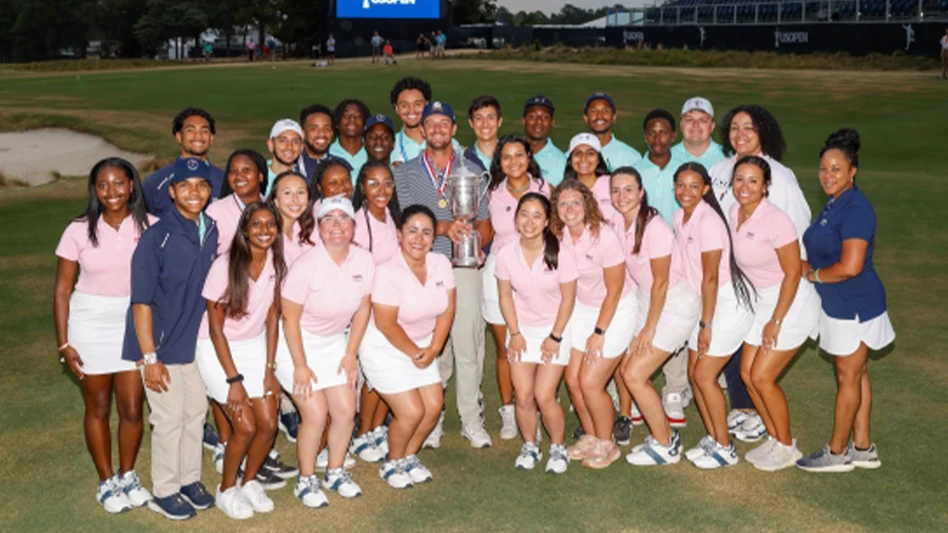

The happenings south of the Firestone Country Club golf course maintenance facility suggest an atypical occurrence.
Forty-nine of the world’s best 50 golfers compete before thousands of spectators as a worldwide television audience follows their shots. Banners, billboards, scoreboards, bleachers and concession stands create a festive atmosphere on the edges of a venerable course.
Inside the maintenance facility, superintendents discuss the land to the north and west. The presence of the World Golf Championship Bridgestone Invitational means another week of juggling maintenance on four courses.
The 600-acre Akron, Ohio, facility includes 63 holes. While the world knows the South course, which has hosted a professional tournament every year since 1954, the crew also maintains the private North and West courses and a nine-hole public course. The entire facility is open during WGC Bridgestone Invitational week, with morning shotgun starts on the North and West courses and a packed tee sheet on the Raymond J. Firestone Public 9.
So, how many volunteers does Firestone recruit to provide support? The answer will surprise almost anybody who has worked on a PGA Tour event.

“My first year we did a written vote: Who would like to have volunteers?” says director of golf course operations Larry Napora, who arrived in 2008. “I think at the time we had 65 employees, and 63 said no. They wrote: It’s our course all year. We don’t need anybody to helps us.” The maintenance team has swelled to 72 employees. Dozens of positions are filled by prideful veterans. One employee has mowed greens on the South course for 43 years, yet he’s still 14 years behind the longest-tenured crew member. A few area teachers spend summers on mowers at Firestone instead of on beach chairs.
Course superintendents John DiMascio (South), Scott Traphagen (North), Renee Geyer (West) and Derek Messina (Raymond J. Firestone Public 9) rely on their experienced employees to introduce Firestone’s philosophies and practices to newcomers. Maintaining the private courses also requires positions to handle the practice range and clubhouse grounds, an irrigation technician, and assistant superintendent who helps DiMascio, Traphagen and Geyer. Four mechanics with more than 100 years of combined experience produce year-round efficiencies.
The crew works split shifts during the WGC Bridgestone Invitational, and DiMascio says every employee will spend time on the South course, which is mowed twice daily when weather cooperates. The North and West courses are also mowed daily during tournament week. The week represents an extension of the year, as DiMascio, Traphagen and Geyer communicate frequently and openly about where to direct personnel.
“After we got the South done for the first round of play, we start talking, ‘We’re trying to get these collars and approaches mowed over here. We need to get this done. How are your bunkers doing?’” DiMascio says. “We are always thinking because you’re not just done with your course. Your course might be shut down for the season, but the North is still open. You’re always thinking about it. It’s a constant thing.”
The agronomic programs on the private courses are similar, although slight tweaks are executed as the WGC Bridgestone Invitational approaches. The South course receives an “extra kick” of fertilizer in the rough and an additional preventative fungicide application before the event, DiMascio says. The courses share equipment and heights of cut are identical for most of the year. The period leading into WGC Bridgestone Invitational week is the most important maintenance stretch of the season. “We start prepping a month in advance,” DiMascio says. “If you don’t have it done by the time advance week is here, you’re not going to get it done.”
Firestone’s high-level conditions are a PGA Tour staple. Chuck Green, the PGA Tour agronomist assigned to the WGC Bridgestone Invitational, says former PGA Tour player and current rules official Dillard Pruitt tells people, “If you don’t like Firestone, then you don’t like pro golf.” The South course opened in 1929 and was originally designed by Bert Way. Robert Trent Jones Sr. redesigned the course in the 1960s. Narrowing fairways and tweaking bunker placement are among the changes in the last 15 years. An operating steel irrigation mainline installed in 1929 still exists below the surface.
The staff notices things every year that can be enhanced. But nobody is ready to overhaul a successful template. “When you have a tournament every year, you’re not reinventing the wheel,” Napora says. “You’re tweaking it.”

Tartan Talks No. 14

Prompted by the late Bob Cupp, John Sanford decided to increase involvement in the American Society of Golf Course Architects. His involvement peaked earlier this year when he became president of the society.
Part of Sanford’s presidential duties included recording a Tartan Talk episode at the Golf Course Builders Association of America summer meeting in Charlotte. The episode featured a little late summer baseball chatter – Sanford’s father, John, pitched parts of 12 major-league seasons – and plenty of golf course architecture discussion. Sanford is based in Jupiter, Fla., and he has numerous ideas about designing strategic golf courses. Enter http://goo.gl/yjjXfe into your web browser to hear the episode.

Want to be a nationally published turfhead?
GCI is giving you a chance for a second straight year.
After debuting to industrywide praise in 2016, Turfheads Take Over will return this December. Contributing to the 2017 issue is a painless process: write around 750 words about any industry-related topic, lesson or experience. Submissions along with applicable photos can be emailed to associate editor Guy Cipriano at gcipriano@gie.net. The deadline to submit an article is Oct. 31, 2017. GCI publisher Pat Jones recommends submitting first-person essays.
Pinehurst Resort’s Bob Farren, Cypress Point’s Jeff Markow, Saucon Valley’s Jim Roney, Des Moines Golf and Country Club’s Rick Tegtmeier, head National Mall turf manager Michael Stachowicz, and Cleveland Metroparks CEO Brian Zimmerman were among the industry leaders who contributed articles to the 2016 Turfheads Take Over. The issue culminated with 2017 Old Tom Morris Award recipient Paul R. Latshaw writing the “Parting Shots” column.
Carolinas pride reigns at PGA Championship
Quail Hollow Club became the first Charlotte, N.C., course to host a major championship last month. Enter http://goo.gl/UxFc3R into your web browser to learn more about the club’s talented agronomic team. In other news involving Quail Hollow, John Deere and club officials announced the formation of the Quail Institute, a program offering one-year fellowships in agronomy, golf operations and club management.


Explore the September 2017 Issue
Check out more from this issue and find your next story to read.
Latest from Golf Course Industry
- Envu Superintendent Grant Program sending 10 members to 2025 GCSAA show
- Editor’s notebook: Let’s chat about AI
- Wonderful Women of Golf 43: Melissa Gugliotti
- This month on Superintendent Radio Network: December 2024
- Mark Hollinger, ASGCA, dies at 70
- Tartan Talks 102: Chad Goetz
- Don’t fly by the seat of your pants
- Golf Construction Conversations: Reed Anderson





